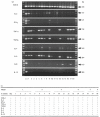Analysis of orbital T cells in thyroid-associated ophthalmopathy
- PMID: 9649211
- PMCID: PMC1904994
- DOI: 10.1046/j.1365-2249.1998.00613.x
Analysis of orbital T cells in thyroid-associated ophthalmopathy
Abstract
Thyroid-associated ophthalmopathy (TAO) has a major effect on the two compartments of the retro-orbital (RO) space, leading to enlargement of the extraocular muscles and other RO tissues. T lymphocyte infiltration of RO tissue is a characteristic feature of TAO and there is current interest in whether these T cells are specifically and selectively reactive to RO tissue itself. We recently established 18 T cell lines (TCL) from RO adipose/connective tissue of six patients with severe TAO by using IL-2, anti-CD3 antibodies and irradiated autologous peripheral blood mononuclear cells (PBMC) to maintain the growth of T cells reactive to autologous RO tissue protein fractions. Here we report on the phenotype characteristics and cytokine gene expression profiles of these orbital TCL and on their immunoreactivity to the organ-specific thyroid antigens thyrotropin receptor (TSH-R), thyroidal peroxidase (TPO) and thyroglobulin (TG). Flow cytometry revealed that 10 TCL were predominantly of CD4+ phenotype, three being mostly CD8+ and five neither CD4+ nor CD8+. Analysis with reverse transcriptase-polymerase chain reaction (RT-PCR) of cytokine gene expression revealed both Th1- and Th2-like products in all TCL: IL-2 product (in 17 TCL), interferon-gamma (IFN-gamma) (n = 10), tumour necrosis factor-beta (TNF-beta) (n = 15), IL-4 (n = 12), IL-5 (n = 17), IL-6 (n = 13), TNF-alpha (n = 12) and IL-10 (n = 4). Reactivity to thyroid antigens was observed only in two TCL, the other 16 being uniformly unreactive. Although 10 out of 18 RO tissue-reactive TCL were predominantly CD4+ there were no significant relationships between TCL phenotype, cytokine gene profile, magnitude of reactivity to RO tissue protein or the (rare) occurrence of thyroid reactivity. The findings of both Th1- and Th2-like cytokine gene expression in all RO tissue-reactive TCL support the concept that TAO is a tissue-specific autoimmune disease, distinct immunologically from the thyroid, and involving both T cell and B cell autoimmune mechanisms in disease pathogenesis.
Figures

Similar articles
-
Analysis of extraocular muscle-infiltrating T cells in thyroid-associated ophthalmopathy (TAO).Clin Exp Immunol. 1997 Aug;109(2):362-9. doi: 10.1046/j.1365-2249.1997.4491347.x. Clin Exp Immunol. 1997. PMID: 9276534 Free PMC article.
-
Thyrotropin-receptor and thyroid peroxidase-specific T cell clones and their cytokine profile in autoimmune thyroid disease.J Clin Endocrinol Metab. 1997 Nov;82(11):3655-63. doi: 10.1210/jcem.82.11.4336. J Clin Endocrinol Metab. 1997. PMID: 9360522
-
Cytolytic T cells with Th1-like cytokine profile predominate in retroorbital lymphocytic infiltrates of Graves' ophthalmopathy.J Clin Endocrinol Metab. 1993 Nov;77(5):1120-4. doi: 10.1210/jcem.77.5.8077301. J Clin Endocrinol Metab. 1993. PMID: 8077301
-
Regulatory B and T cell responses in patients with autoimmune thyroid disease and healthy controls.Dan Med J. 2016 Feb;63(2):B5177. Dan Med J. 2016. PMID: 26836805 Review.
-
Thyroid-associated eye disease.Strabismus. 2000 Jun;8(2):101-11. Strabismus. 2000. PMID: 10980691 Review.
Cited by
-
Interruption of autoimmunity for thyroid eye disease: B-cell and T-cell strategy.Eye (Lond). 2019 Feb;33(2):191-199. doi: 10.1038/s41433-018-0315-9. Epub 2019 Jan 4. Eye (Lond). 2019. PMID: 30610229 Free PMC article.
-
Immunohistochemical analysis of human orbital tissue in Graves' orbitopathy.J Endocrinol Invest. 2020 Feb;43(2):123-137. doi: 10.1007/s40618-019-01116-4. Epub 2019 Sep 19. J Endocrinol Invest. 2020. PMID: 31538314 Review.
-
Current concepts in the molecular pathogenesis of thyroid-associated ophthalmopathy.Invest Ophthalmol Vis Sci. 2014 Mar 20;55(3):1735-48. doi: 10.1167/iovs.14-14002. Invest Ophthalmol Vis Sci. 2014. PMID: 24651704 Free PMC article. Review.
-
Platelet-derived growth factor: a key factor in the pathogenesis of graves' ophthalmopathy and potential target for treatment.Eur Thyroid J. 2014 Dec;3(4):217-26. doi: 10.1159/000367968. Epub 2014 Dec 6. Eur Thyroid J. 2014. PMID: 25759797 Free PMC article. Review.
-
New understanding of the role of cytokines in the pathogenesis of Graves' ophthalmopathy.J Endocrinol Invest. 2004 Mar;27(3):237-45. doi: 10.1007/BF03345272. J Endocrinol Invest. 2004. PMID: 15164999 Review.
References
-
- Burch HB, Wartofsky L. Graves' ophthalmopathy. Current concepts regarding pathogenesis and management. Endocr Rev. 1993;14:747–93. - PubMed
-
- Weetman AP. Thyroid-associated eye disease: pathophysiology. Lancet. 1991;338:25–28. - PubMed
-
- Smith TJ, Bahn RS, Gorman CA, Cheavens M. Stimulation of glycosaminoglycan accumulation by interferon gamma in cultured human retroocular fibroblasts. J Clin Endocrinol Metab. 1991;72:1169–71. - PubMed
-
- Kahaly G, Stover C, Otto E, Beyer J, Schuler M. Glycosaminoglycans in thyroid-associated ophthalmopathy. Autoimmunity. 1992;13:81–88. - PubMed
MeSH terms
Substances
LinkOut - more resources
Full Text Sources
Medical
Research Materials
Miscellaneous

